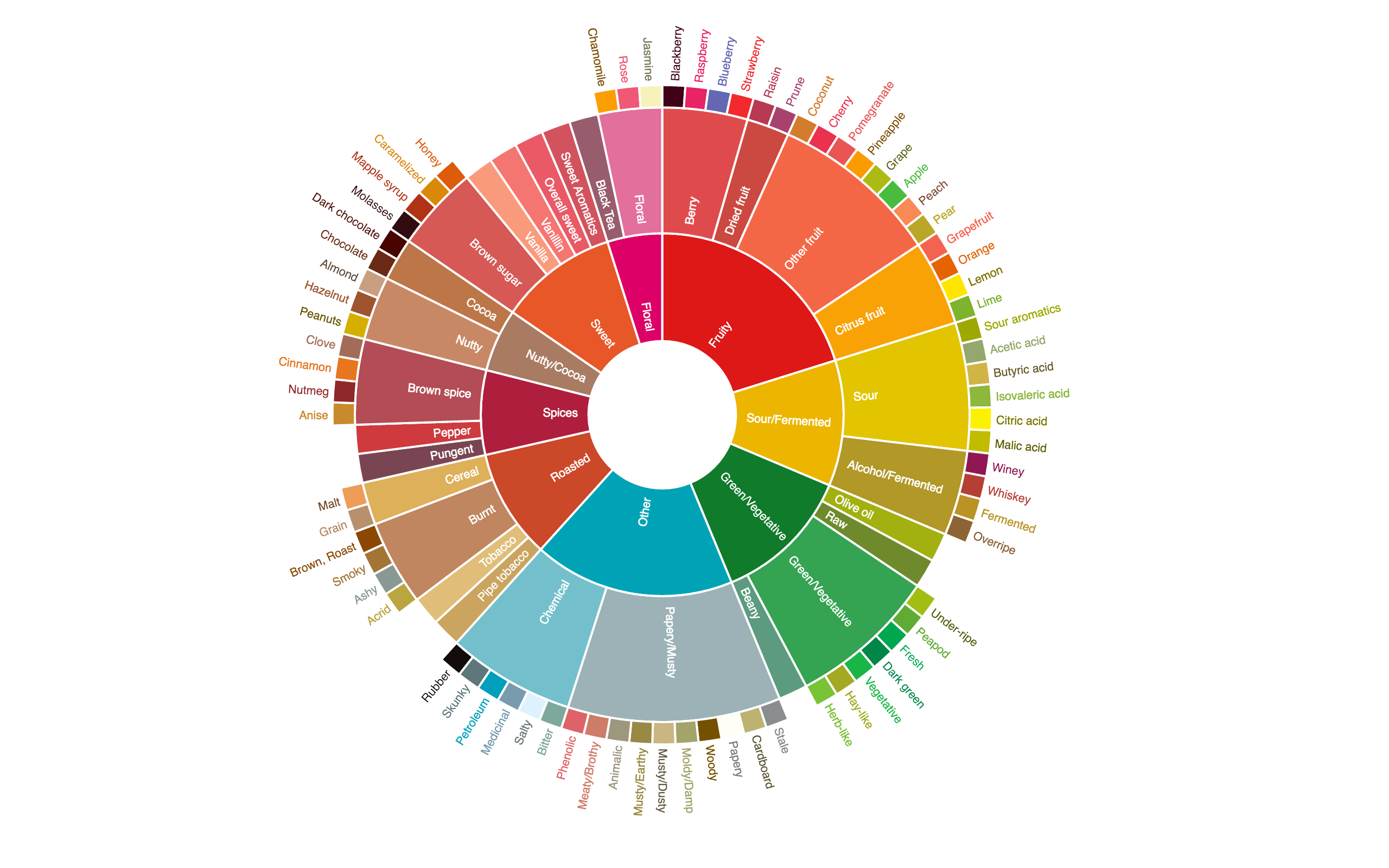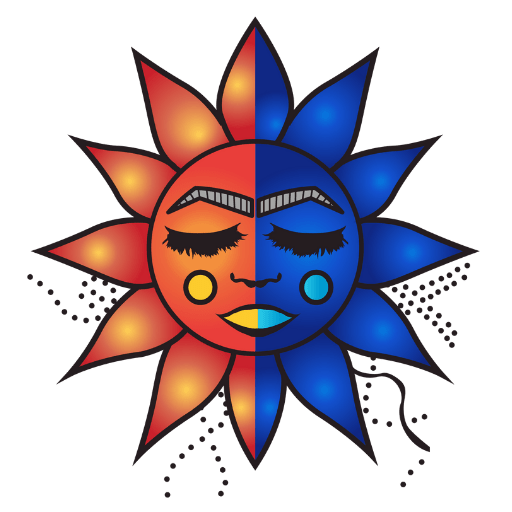The 4 Different Types of Coffee Beans, Explained.
Did you know that there are four different types of coffee beans? Do you know which type of coffee is best? On this page, we will certainly answer all your questions about the different coffee types their characteristics. In addition, we will explain what sets them apart with helpful pictures and graphs. Indeed, the four (4) different types of coffee beans are Arabica, Robusta, Liberica, and Excelsa. Please note: The four coffee types break down further into multiple coffee varietals. A varietal is another way saying “type” of coffee. Just like there are different “types” of apples (granny smith, gala, macintosh).
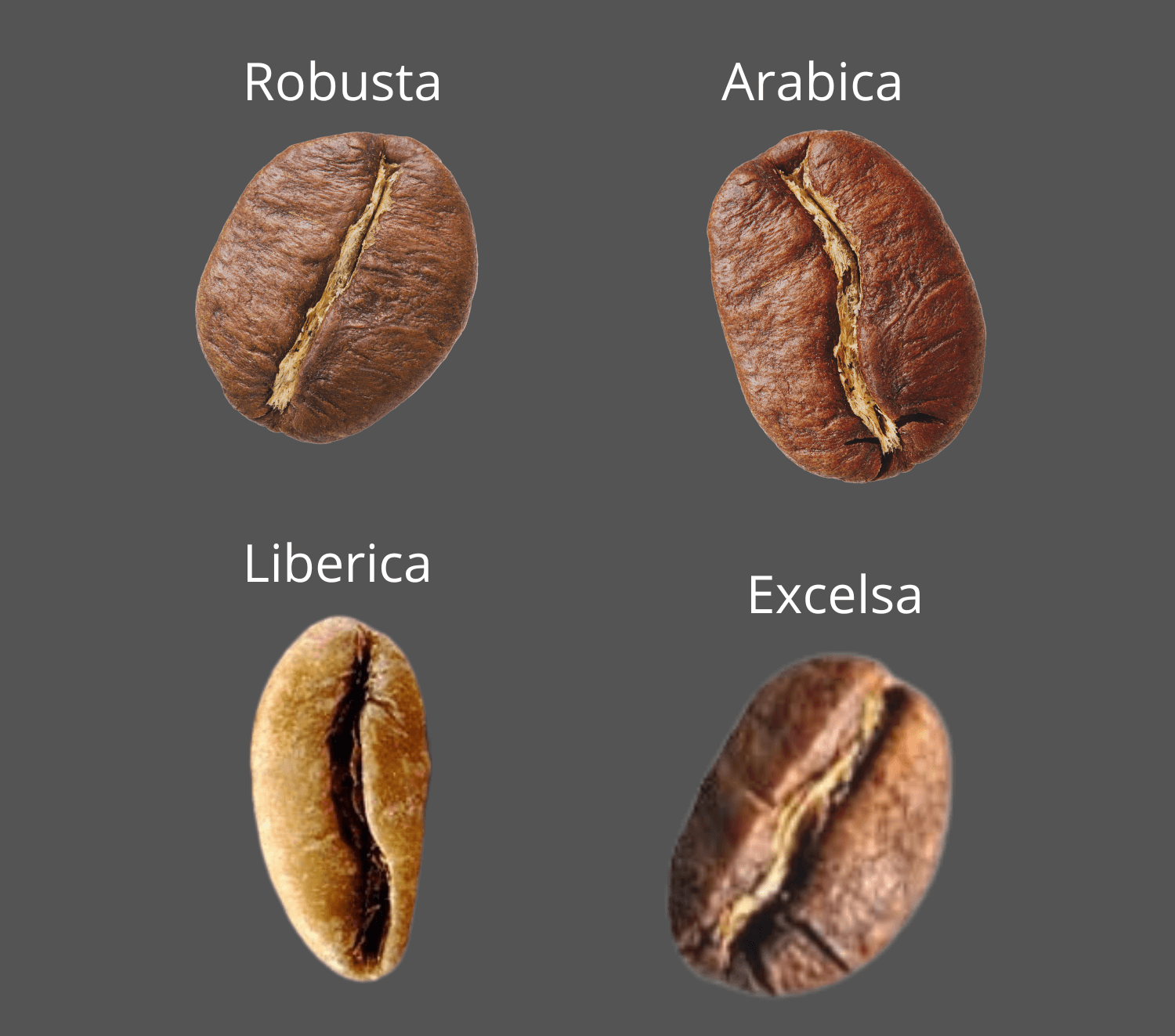
What exactly is a coffee bean?
First off, a coffee bean is a seed from a fruit (coffee cherry) that grows on a coffee plant. The coffee fruit ripens depending on the climate; Arabica coffee at around seven months, while Robusta coffee matures in nine months. Once ripe, the coffee farmers pick the seeds (coffee bean) by hand during harvest. The seeds of the coffee plant contains four essential parts: the seed “coffee bean”, a gel-like coating called “silver skin”, the pulp, and the outer skin. Furthermore, the seeds are processed in two ways: Wet Process and Dry Process. Lastly, the green coffee beans are sold to coffee companies in 50-70 kilo jute bags. The coffee roasters roast the green coffee beans to the brown color your familiar with and sold for consumption.
1. Arabica coffee
Arabica coffee is a type of coffee bean from the “Coffea Arabica” coffee plant, a flowering plant that belongs to the botanical family Rubiaceae. It is a shrub with evergreen leaves that can grow up to 20 feet tall with proper care. Arabica originates in southwestern Ethiopia. However, it traveled to Yemen where it was first cultivated for farming. It is also believed to be the first type of coffee ever cultivated. As a matter of fact, it received its name from Arabia when the bean crossed the Red Sea from Ethiopia to Yemen. Since then, at the beginning of the 17th century, the term “arabica.” was considered the first botanical term to describe a coffee tree. Furthermore, Arabica coffee beans are the most popular and widely available coffee beans globally. In fact, it contains over 60% of the world’s coffee production. Here at Rivas Coffee, we only offer Arabica coffee beans for our wholesale coffee and subscription coffee products.
Arabica Coffee Facts
Arabica coffee beans
Arabica coffee beans are great for espresso, cold brew, drip coffee, pour overs, and more. It contains more sugar and lipids than any other type of coffee bean; therefore improving the aroma and body of the coffee. In addition, the sugar makes Arabica coffee taste better, have a cleaner mouthfeel, and a noteworthy decrease in bitterness.
Arabica coffee beans are the most expensive coffee of the four types. You will find that all expensive, high-quality coffee is almost always 100% Arabica. It is undoubtedly the world’s best-tasting beans. You can certainly purchase Arabica coffee beans on our online coffee store.
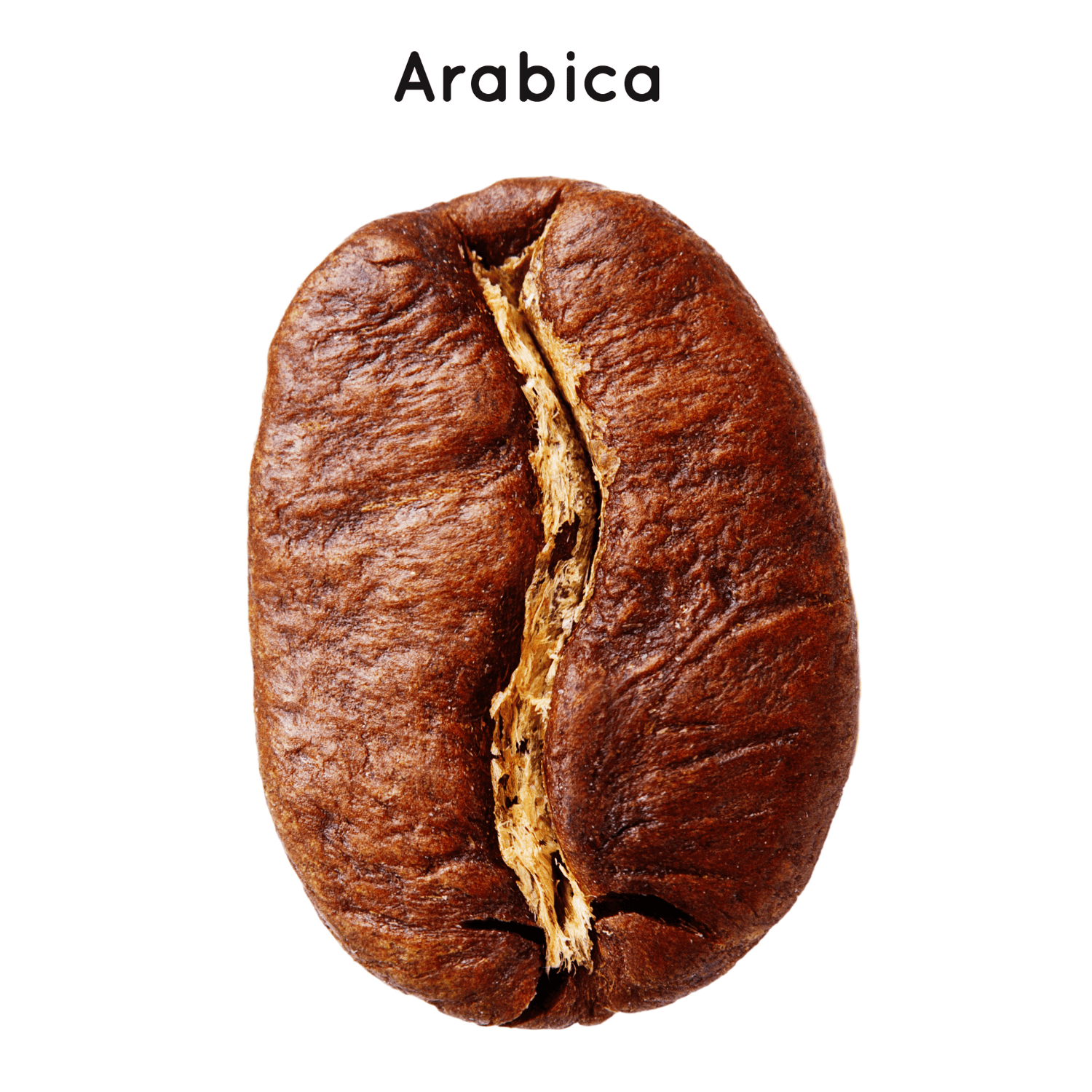

How does Arabica coffee grow?
Arabica coffee grows in higher elevations along the “Bean Belt”, a band around the Earth in between the Tropics of Cancer and Capricorn. The ideal growing temperature is between 59 to 75 F. In fact, Arabica is so delicate that temperatures at even 85 F can damage the plant. On the other hand, the height of the elevation plays an important role in the flavor profile of the coffee. Coffees grown at higher elevations (2200 masl), such as Ethiopian coffee, have delicate floral and fruity flavors. However, lower elevation coffees (1500 masl), such as Guatemalan coffee, showcase nutty, chocolatey, and earthy flavors. Furthermore, the growing conditions must fit the environment necessary for proper development. For instance, it requires rich soils with few pests or diseases, moderate rainfall, and soil fertilized by volcanic ash. Indeed, it is difficult to grow; therefore, the pricing reflects a premium commodity.
What does Arabica coffee taste like?
Arabica coffee is considered supreme to all coffee types due to its taste. It showcases incredible complexity, sweetness, and acidity. Naturally, Arabica coffee receives a high cupping score. It features a wide range of different tasting notes than its counterparts. From fruity/floral to cocoa/nutty, there are many different flavors that coffee roasters can extract in Arabica coffee. For example, light roasts contain more acidity, making them more winey and delicate with fruit or berry tones. However, coffee roasters can caramelize it into chocolate drizzled fruit, caramel, or dark chocolate in medium or dark roasts.
Many coffee enthusiasts drink Arabica coffee beans due to its exquisite taste. In fact, they typically seek an excellent drip coffee or pour-over coffee since it provides a sweeter and more balanced cup of coffee. In addition, it showcases a notable lack of bitterness since it contains the most amount of sugars as any other coffee type. Thus, making it easier to drink without sweeteners or cream. Furthermore, coffee roasters enjoy roasting Arabica coffee beans since they can extract desirable high-quality flavors for customers. Most specialty coffee bags use it due to its complexity and smooth finish. It is featured as single-origin coffee, coffee blends, espresso beans, and decaf coffee. In this picture, you will see the tasting analysis of a specialty Arabica coffee from Burundi.
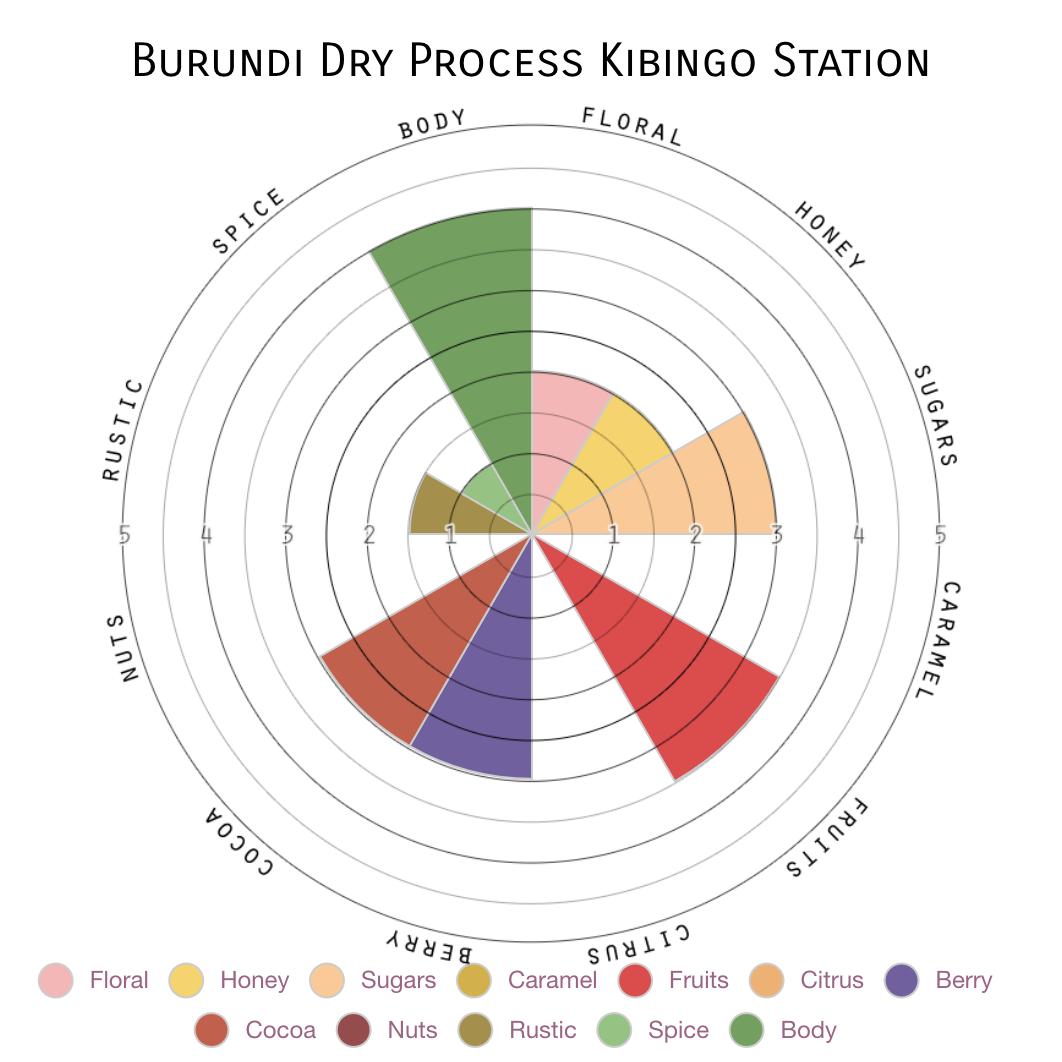
Arabica Q grader
Did you know there is a certification called “Q Arabica Grader” for professionally tasting Arabica coffee beans? It is an individual with the CQI (coffee quality institute) credentials to grade and score Arabica coffees. These Q Graders utilize the standards of the Specialty Coffee Association of America (SCAA).
Furthermore, the Q Arabica Grader license is open for any person to apply for. There is no college degree or course required prior to starting this commitment. However, if you have no coffee experience or are new to tasting and cupping coffee, this class is not recommended. It is a highly advanced class that takes coffee tasting to the next level. The course for becoming a Q Arabica Grader prepares participants for the 22 tests they must pass to become a certified Q Grader. The tests relate to an individual’s ability to accurately and consistently taste and grade coffee according to SCAA cupping and grading standards. This includes a thorough understanding of the SCAA cupping form. A student who passes these 22 tests is given a professional license as a Q Grader. The Q Arabica Grader license must be renewed every three years by attending a Q Grader calibration to ensure the Q Grader is up-to-date. If you or someone you know is interested in becoming a professional Q Arabica Grader, follow our link to learn more.
In the picture above, you will see the Specialty Coffee Association’s Coffee Taster’s Flavor Wheel. It is a sensory tool, designed to help you taste Arabica coffee and distinguish good from bad flavors. Click on the picture to learn more.
2. Robusta coffee
Robusta coffee is a type of coffee bean from the “Coffea Canephora” coffee plant. It originates in central and western sub-Saharan Africa. Moreover, it is the second most popular coffee globally, making up 40% of its coffee production. Most instant coffees contain Robusta coffee beans due to their high caffeine content. In fact, Robusta contains the most caffeine content of all coffee types. Robusta coffee beans are often bitter and harsh.
Robusta Coffee Facts
Robusta coffee beans
Robusta coffee beans are great for espresso, cold brew, drip coffee, pour overs, more. It contains more sugar and lipids than any other type of coffee bean, therefore improving the aroma and body of the coffee. In addition, the sugar makes arabica coffee taste better, have a cleaner mouthfeel, and a noteworthy decrease in bitterness. You can purchase Arabica coffee beans at most cafes, coffee shops, restaurants, and grocery stores.
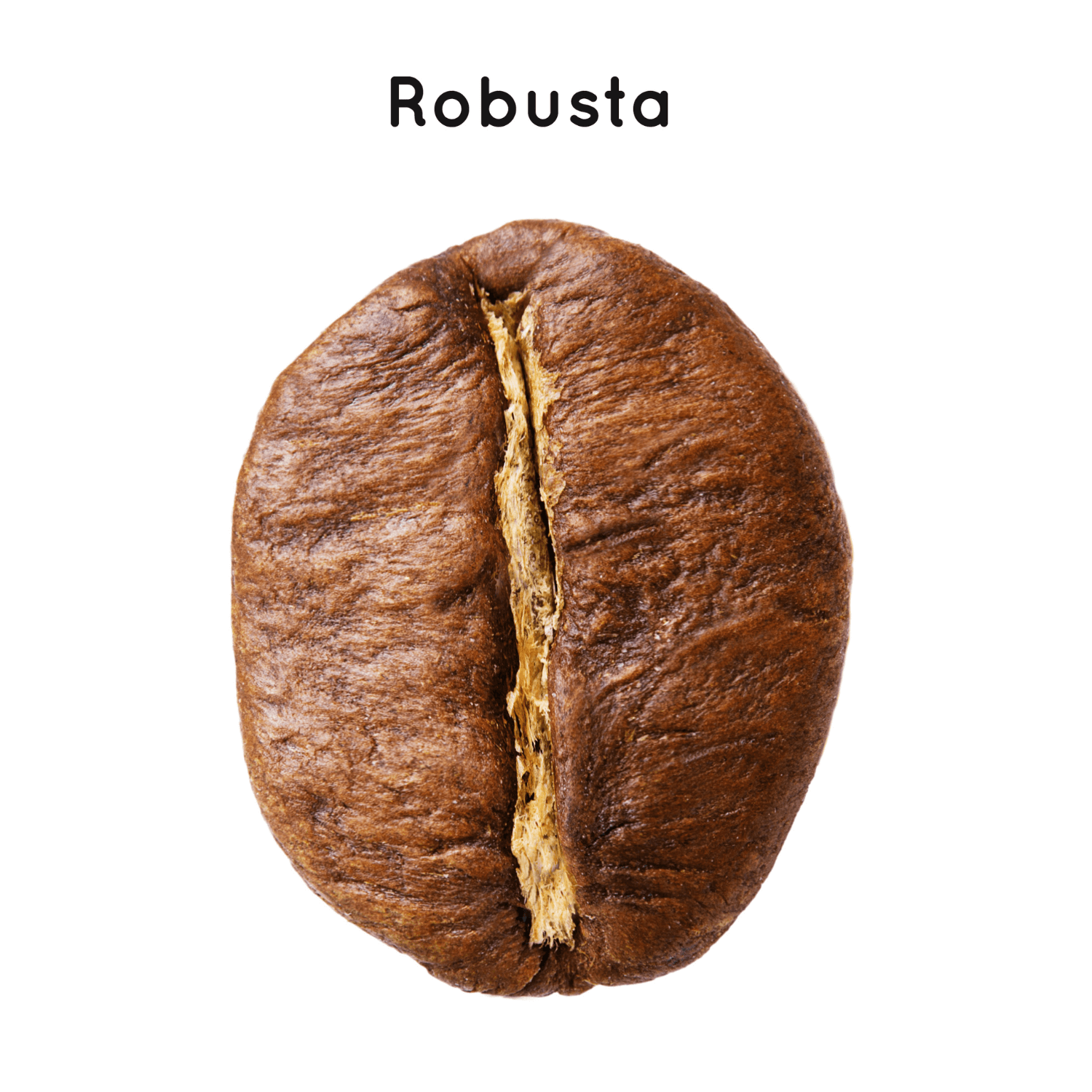

How does Robusta coffee grow?
Robusta is grown along the equator, typically in tropical areas and elevations between 1500-2200 masl. Surprisingly, the height of the elevation plays an important role in the flavor profile of the coffee. Coffees grown at higher elevations (2200 masl), such as Ethiopian coffee, have delicate floral and fruity flavors. However, lower elevation coffees (1500 masl), such as Guatemalan coffee, showcase nutty, chocolatey, and earthy flavors. Furthermore, the growing conditions must fit the environment necessary for proper development. For instance, it requires rich soils with few pests or diseases, moderate rainfall, and soil fertilized by volcanic ash. Indeed, it is difficult to grow; therefore, the pricing reflects a premium commodity.
How does Robusta coffee taste like?
Robusta coffee often tastes earthy and dark, with grain-like flavors. Due to its lower sugar content, it tastes more robust and bitter. In that case, it is not recommended as black coffee since the bitterness is overbearing. It is preferred to brew it as espresso since it provides a nice thick crema with a bold mouthfeel.

